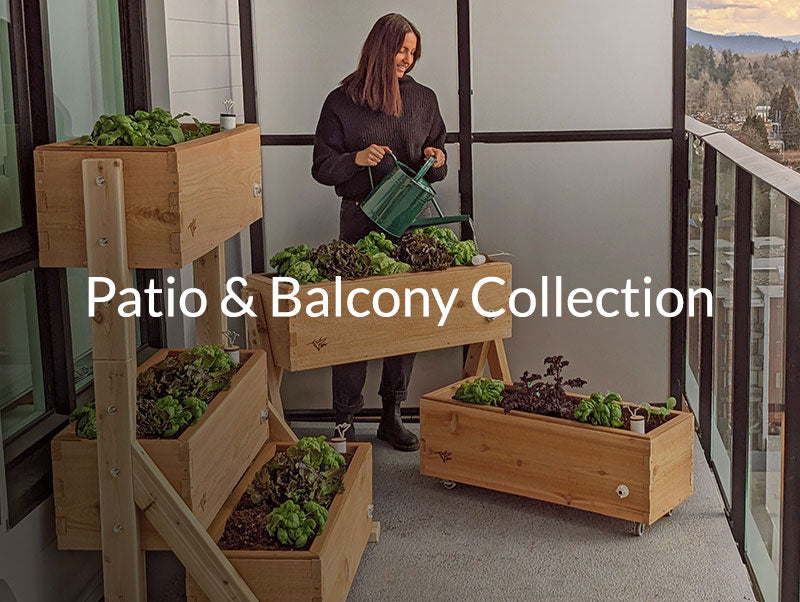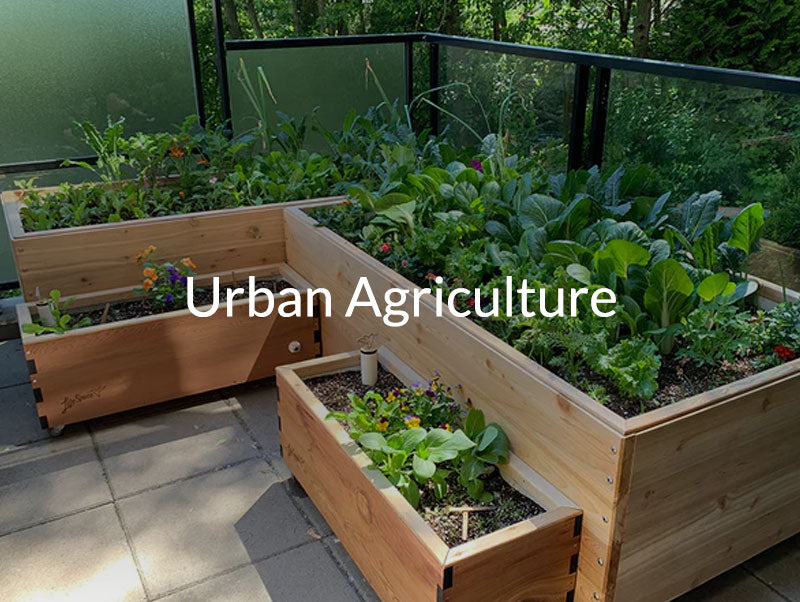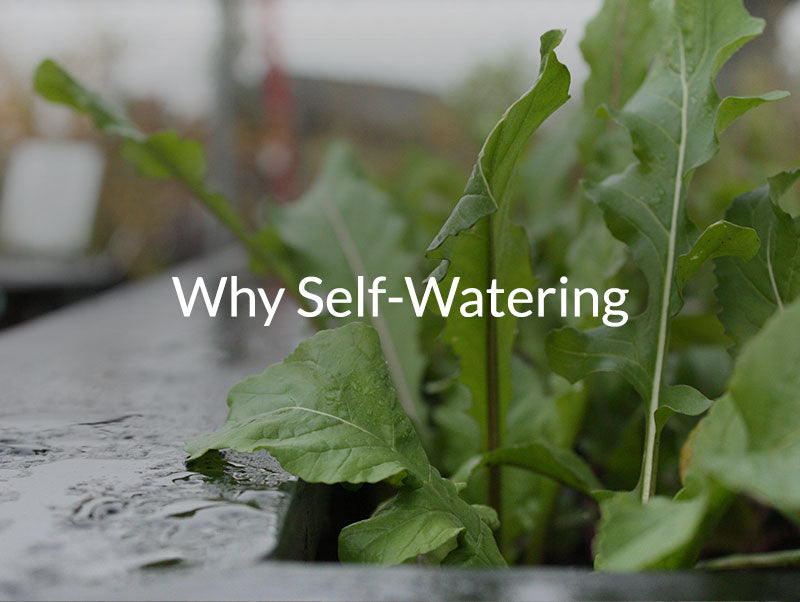Frequently Asked Questions
Check most frequently asked questions here, if you still need help then please contact us at info@lifespacegardens.com
Installing your garden
No. But if vermiculite is available to you, it does make an excellent wicking material to install in your GardenWells, as it's highly absorbent, inert, and doesn't decompose over time. With all that being said, filling your GardenWells with a container blend soil will work just fine, and you'll be self-watering no problem. Vermiculate is preferable but not necessary.
Make sure the site your installing your LifeSpace Garden or GardenWell garden is level and free from obstruction. You want to make sure that
- Nothing will puncture the liner
- The garden is level so the reservoir/self-watering will function correctly.
If in doubt, position the OverFlow valve of your garden on the low side so the reservoir never overfills above the GardenWells into the soil zone.
Ideal surfaces are level and free from obstructions that could puncture the liner. Drainage is also important. For the longevity of your garden/woodwork you want to ensure that the location of your installation is free draining and free from pooling water.
Ideal surfaces are:
- Level wooden/synthetic decks
- Level concrete patios/pavers
- Level riverrock/pea gravel areas
- Level sandy areas
- Level rooftops/roofing material
Secondary Locations:
- Level bark/mulch areas
- Level grassy areas
Not suggested if liner will be in direct contact:
- Road base (potential puncture over time)
- Crushed gravel (potential puncture over time)
- Exposed dirt/soil (potential puncture over time)
Within 1/8th of an inch over 4' is acceptible. Your LifeSpace Garden or GardenWell garden will function out of level, but you want to ensure the OverFlow of your garden is always positioned at the low point. This way the reservoir will never encroach about the GardenWells into the soil zone - which is key! - however, if your garden is significantly out of level, you will lose reservoir capacity making reservoir fills more frequent.
The right soil blend is very important for optimal self-watering functionality of your LifeSpace or GardenWells garden. If shopping at your nursery or garden center, look for a "container blend." The key here is looking for either coconut coir or peat moss and a significant ingredient which helps with water retention and soil friability. Perlite or vermiculite will also be present. If in doubt please feel free to reach out!
The Squarefoot gardening method is simply the best way to plan and manage your garden. Discover how many of each type of veggie you can plant per squarefoot.
Great Question! Your LifeSpace / GardenWell garden functions through capillary action - "Capillary action is the ability of a liquid to flow in narrow spaces without the assistance of, or even in opposition to, external forces like gravity. "
The problem is that in it's dry state, soil is actually hydrophobic, meaning that it will resist getting wet. So if you put a bunch of dry soil on top of even the most perfectly full water reservoir, no capillary action... it will stay dry. So to kick off that self-watering magic, thoroughly top water first until you soil is even and consistently moist - then your soil will want to stay moist, and will continuously draw water up from the reservoir to create the perfect growing environment!
In summary:
- Install GardenWells
- Fill garden with container blend soil
- Water thoroughly from top to kick off capillary action
- Fill reservoir
- Watch your garden thrive!
If you choose to overwinter your garden, here are some tips to protect your crops:
- MULCH
Mulching your garden over the winter is a must, especially if you plan on growing through the winter months. Also using cold frames, cloches or row covers will extend your harvest into the winter months. This will prevent shock to root systems if you are overwintering veggies. Using a thick layer of leaves on your garden is the easiest and most cost-effective mulch.
- MOVE UNDER COVER
If you have a mobile garden, roll it against a wall or under cover to give a little extra protection for your plants. If you live in a colder climate, extending fall veggies may not be an option. We highly suggest doing some experimentation to see what works best for your space.
- CROP COVERS
Overwintering crops in colder climates presents more of a challenge, and we absolutely suggest doing some experimentation. However, cover crops may be a more achievable option than edibles. Some cold weather cover crops include fava beans (hardy to -17), winter field peas (hardy to -23) and crimson clover (hardy to -23). Avoid planting garlic and fava or broad beans together, it will stunt growth!
- WHAT TO PLANT
If the plan is to grow food over the winter, there are a few options. Endive, radicchio, spinach, bok choi, radish and mustard greens are great examples of crops that you can plant mid-october and protect for a winter harvest.
Location & Applications
The ideal garden location is a combination of sun exposure and convenience. Ideally, the more sun the better! But you also want your veggie garden in a place you can harvest from everyday or at least 2-3 times per week.
One of the wonderful about GardenWells is that they allow you to grow just about anywhere. Because you only have to fill the reservoir 8-12 times per year (in Vancouver) it makes those tough to irrigate locations more than manageable. Also, by creating a sealed garden with single overflow, it allows you to control all drainage and mess which is often a significant issue with growing in urban spaces.
4-6 hrs for leafy green and herbs.
6-8hrs for roots, shoots, & vines.
8hrs+ and you'll be happily growing all your favourites!
100%!!! One of the huge benefits of our CondoFarm collection is that they are tailored for small space urban growing. Compact, self-watering, no mess gardens that are ideal for urban dwellers and the modern lifestyle.
Absolutely not! We just love growing veggies anywhere we can! But the truth is, sub-irrigation is ideal for growing any type of plant that thrives on even consistent moisture... which tends to be most of them!
Yes. Fruit trees, decorative bushes, garden shrubs all thrive with sub-irrigation. Especially in urban environments where space is limited, the built in reservoir will allow you to save on soil volume as well. Simply position the rootball of your tress or bush within the capilliary zone (8-12" from the GardenWells) and your plants will benefit from the even and consistent moisture that no other irrigation system can achieve.
Maintenance
Over the last 8 years in the Pacific Northwest, we've found that a LifeSpace Garden, or a garden with GardenWells installed - needs the reservoir filled between 8-12 times a year on average. Monitor the float gauge on your garden at least once a week, or more during peak summer heat, but the following projections can be used as a guide.
- March: Fill reservoir with first planting
- April: 0-1x
- May: 1-2x
- June: 1-3x
- July: 2-4x
- Aug: 3-4x
- Sept: 1-2x
- Oct: 0-1x
Fertilizing is best done by amending your soil with nutrient rich organic compost after every crop. Once you're done harvesting, amend your soil with compost to bring the volume of soil back up to the top of your garden. If you're diligent in your amending, you should be able to limit the amount of additional fertilization required. However, if you have over planting, or growing heavy feeders, you can consider using an organic liquid fertilizer or compost tea to boost your garden at key points like flowering or the beginning of fruit set.
Maybe yes, maybe no. The "conventional" container grower will replace their soil every year or every second year. There is however another school of throught that beleives in creating a living soil full of bioactive organisms. It's really up to you. Start fresh every year, or start putting the energy into growing your soil as much as you grow your garden. Ask us how!
We build LifeSpace Gardens with sustainability at the forefront. The cedar we source takes a long time to grow, so we make it our mission to build your garden to last for years and years. Just as you would do with a deck or fence, refinish the Garden every few years to help them last to their full potential. Your LifeSpace Garden will become as much a part of your family as your home. Everything we use to build your garden has been designed to withstand the elements. With that being said, over time you may find that the finish of your garden will begin to wear... this is unavoidable. At this point you can apply a new exterior stain to your garden, or you can allow it to weather naturally.
Once a year:
- Clean the exterior or your garden and lubricate wheels if installed.
- Test soil for PH and nutrients if desired
- Refinish wood work if desired
- Use enzyme reservoir cleaner if desired
If your garden has one of our premium exterior finishes, you can either let it weather naturally, or refinish your garden ever 1-2 years to keep it looking fresh.
Once a Week:
- Check your reservoir
- Prune/thin/trellis/check for pests
- Harvest what's ready!
Every 2 weeks:
Fertilize if required
Every Season:
- Harvest the season's bounty!
- Remove old plants
- Check OverFlow for blockage
- Add organic compost / worm castings to top up soil level and replenish soil fertility
Once a year:
- Clean the exterior, lubricate wheels.
- Test soil for PH and nutrients if desired
- Refinish wood work if desired
- Use enzyme reservoir cleaner if desired
LifeSpace Gardens are built to last, so even our large garden styles will survive the winter.
GARDEN COVER:
If you wish to prolong the life of your garden covering it with a tarp, BBQ cover, or wood board is a good idea. This will also help protect the stain, meaning there will be less need for touch ups and you won’t need to re-stain your garden as often. For any mobile gardens, we recommend pulling them back under the roof line and against your house to further protect plants and the cedar box from intense winter rains.
DRAIN WATER RESERVOIR:
If your garden is under cover, we recommend draining your reservoir. If it is not under cover, your reservoir will drain and refill naturally with the rain - this is absolutely fine. TheLiner, GardenWell inserts, and Cedar Box will flex and bend with the ice and the rain without cracking or breaking. However using Enzyme complete can help break down organic matter (roots) int eh reservoir and convert them to nutrients so be absorbed back up into the garden.
CLEAN UP:
It is so important to clean up your garden after your fall veggies have ended their cycles. Pests and disease can over winter in the soil. Make sure you clean up the debris and decaying plant matter and do a thorough weed to ensure your garden will not carry anything into the next growing season. An Enzyme Complete cleanse of your soil is recommended.
Once a Week:
- Check your reservoir
- Prune/thin/trellis/check for pests
- Harvest what's ready!
Every 2 weeks:
Fertilize if required
Every Season:
- Harvest the season's bounty!
- Remove old plants
- Check OverFlow for blockage
- Add organic compost / worm castings to top up soil level and replenish soil fertility
Once a year:
- Clean the exterior, lubricate wheels.
- Test soil for PH and nutrients if desired
- Refinish wood work if desired
- Use enzyme reservoir cleaner if desired
Self-Watering Questions
The magic of sub-irrigation is that it mimics the natural water tables found in all the most abundant natural environments. Soil on top, water underneath. This allows water to wick up as needed, creating the perfect growing environment for you plants to thrive! Simply fill the reservoir and your garden does the rest. Sub-irrigation is the secret to a self-watering garden.
Yes absolutely! GardenWells are entirely modular and can be applied to gardens of almost any shape and size. For more information on how to build a self-watering garden using GardenWells, check out this blog.
Installing GardenWells is a very straight forward process. For step by step instructions, check out this blog
GardenWell / SIP (Sub-Irrigated Planter) System is comprised of 4 compontents:
- Waterproof liner
- GardenWell tile inserts
- OverFlow
- WaterStem (Fillup tube and Float gauge)
For more info on each component, check out the product collection page here.
Save Water
Compared to traditional watering techniques, up to 80% less water is required. Evaporation is limited as water is held under the soil. Reservoirs can go a week or longer in between required fill ups.
Longer Life
Wood/Cedar is fully protected from soil/water by the waterproof liner, this eliminates chances of rot and greatly improves longevity and aesthetics of your planter.
Less Soil
Because water is always available, root systems are smaller so less soil depth is required than traditional raised beds: 8-12" of growing medium depth is suggested for veggies and most annuals.
The average planter equipt with the GardenWell system growing in the Pacific North West, requires 8-12 reservoir fills per year and can conserve up to 80% of the water compared to traditional top watering techniques. We recommend monitoring your garden at least once a week during the growing season, just to make sure your garden is growing well even if your reservoir doesn't need filling. However in Vancouver, the following is an average reservoir fill schedule, adjust for warmer climates:
April: 1x
May:1-2x
June: 2-3x
July: 3-4x
Aug: 3-4x
Sept:1-2x
The beautiful thing about GardenWells is the built in OverFlow valve. This ensures that the reservoir never floods the soil. If it rains a lot, or you accidentally over fill your reservoir, any excess water will simply drain away out the OverFlow.
The other main benefit of the OverFlow, is that it always allows oxygen to get to the soil/roots. With proper level installation of your LifeSpace Garden or GardenWell system, there will always be an air space between soil and water that eliminates anaerobic rot.
Forget about GardenWells as a self-watering system for a second, and think of it as a water control/drainage system. The beauty of the GardenWell system is that it captures and sequesters rain fall into a reservoir hidden under the soil. Any excess water is drained out via the built in OverFlow which can be hooked up to a drainage system and directed wherever you life. This mess free application is extremely beneficial for many urban environments such as rooftop gardens and patio gardens.
Forget about GardenWells as a self-watering system for a second, and think of it as a water control/drainage system. The beauty of the GardenWell system is that it captures and sequesters rain fall into a reservoir hidden under the soil. Any excess water is drained out via the built in OverFlow which can be hooked up to a drainage system and directed wherever you life. This mess free application is extremely beneficial for many urban environments such as rooftop gardens and patio gardens.







